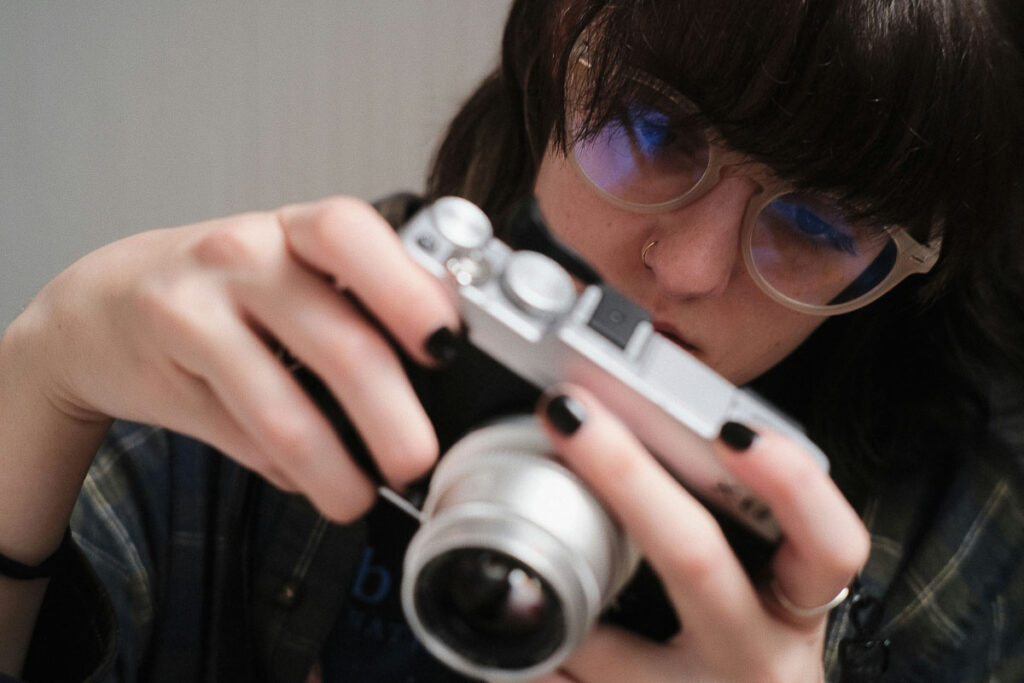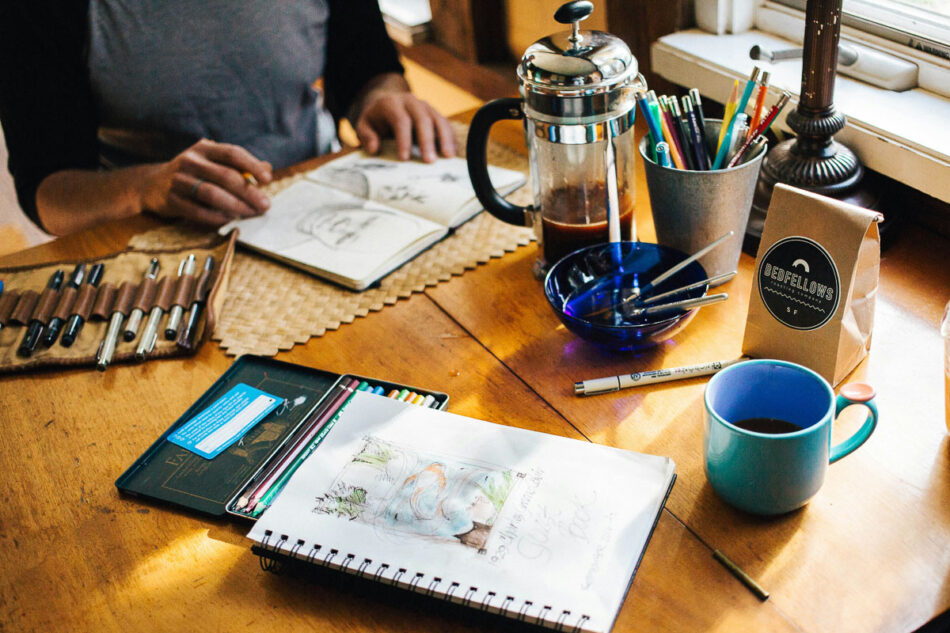Developing a creative practice is non-negotiable if you want to effortlessly tap inspiration and sidestep creative ruts and blocks.
Have you ever sat down to work feeling completely uninspired?
Perhaps you’ve found yourself wrestling with a lack of motivation to finish what you started (or even to just get started in the first place)?
Maybe you’re the sort of person who, despite all this, pushes on through?
Yet you still feel frustrated, restless or fed up, and can’t shake the sense that you’re losing momentum, becoming stagnant, or (scarily) falling out of love with what you do.
If so, this blog post is for you.
I’ve definitely been in slumps that feel a little more serious than garden variety writer’s block.
And I’ve learned the solution isn’t to double down.
Almost always, such feelings are the first sign that something’s out of whack with my creative practice.
When I identify what it is, and put a plan in place to tackle it, the words start to flow again.
Don’t just take my word for it.
The following strategies are backed by science.
They will help you, too, develop a creative practice which will pave the way towards you producing your best work.
What is a creative practice?
There’s no one definition of creative practice.
But I think of it as a system of scaffolding designed to support the work I do, in terms of nurturing inspiration, promoting deep focus, boosting discipline, and enhancing skills.
For artists, writers, illustrators, and other creatives, a creative practice involves setting aside dedicate time to work on their craft, experiment with new techniques, and figure out, ‘What’s next?’
It’s doing ‘the thing’ daily (which is, after all, the definition of a practice).
This establishes a rock-solid routine that fuels creative growth, consistency and originality.
It also builds resilience so creatives can weather inevitable challenges, self-doubt, and rejection.
How do I build a creative practice?
There’s no one-size-fits-all model for creative practice.
However, here are some science-backed strategies that work for me and others.
Sit in stillness
Some people baulk when you suggest spending even a short amount of time in meditation.
They’ve previously found it impossible to quiet the mind, feel too time-pressured, have been flooded with unpleasant emotion, or are simply sceptical about the benefits.
Yet developing the ability to sit in silence is essential in a world in which we have about 60,000 thoughts a day (75% of them negative).
This is because meditation reduces ‘mental noise’, thereby amplifying the signal-to-noise ratio of your thoughts, says cognitive neuroscientist Moshe Bar, author of Mindwandering: How It Can Improve Your Mood and Boost Your Creativity.
Meditation filters out the fluff, allowing stellar ideas to swim to the surface.
Once you enter silence, and stillness, and stop all the conscious striving, your brain shifts into a state in which the default mode network (DNM) quietly chugs away to come up with the solution to whatever problems you’re facing.
“It gives you the sublime power not only to understand your thoughts, but also to exert at least some control over them,” Bar writes.
If you’ve tried meditation previously, and hated it for some reason, then I’d urge you to give it another shot.
There are a host of different forms of meditation, including body scans, mantra meditations, progressive muscle relaxation, and walking meditations.
One of these might just work for you.
Do stuff just for fun
Ensure your daily routine includes things you love to do.
That might mean taking a long, leisurely shower, savouring a healthy breakfast in the sunshine, or walking the dogs down to the local café (my absolute go-to favourite).
Joy and enthusiasm are contagious – and naturally spill over into your approach to work.
Recent research has also identified that people in a good mood tend to be more creative and better at solving problems that require insight and ‘aha!’ solutions.
They also have access to more unusual information in memory than people in a negative mood, according to Bar.
“For example, if people are asked to name a means of transportation, the typical response will be ‘car’,” he writes.
“A person in a positive mood, however, is more likely to respond more originally with ‘elevator’ or ‘camel’ to the same question.”
He suggests that positive mood might be an evolutionary reward for broad thinking.
“(It) might be nature’s way of encouraging us to explore, learn, and be creative,” Bar adds.
“Look long and wide for the new rather than exploit the familiar.”
Having fun also helps you tap into more flexibility, fluency and originality of thought. Read more on How to become a highly divergent thinker.

Carve out time for ‘deep work’
It’s estimated that we all lose at least two hours a day due to distractions.
And if you’re not vigilant, whole days can go by where you’re responding to the needs, wants, and priorities of other people, rather than working on the projects that matter most to you.
For that reason, Gary Keller, author of The One Thing, recommends time blocking.
Time blocking involves carving out four hours every day to work on your most important project without interruption from others – or yourself.
“There’s always other stuff screaming to be done,” he writes.
“When stuff pops into your head, just write it down on a task list and get back to what you’re supposed to be doing.”
Keller suggests safeguarding your time block in the following four ways:
Build a bunker
Hang a ‘Do not disturb’ sign, installing shades or a folding screen, or finding an alternative workspace altogether.
Store provisions
Ensure you have ready access to supplies, materials, snacks, or drinks, so you don’t need to leave your bunker (except for the loo).
Sweep for mines
Minimise interruptions by turning off your phone, closing down email, and exiting all browsers.
Enlist support
Let people who are most likely to seek you out what you’ll be doing and when you’ll be available.
Take regular time out to rest
When you’re under sustained deadline pressure, rest can feel like an impossible luxury.
But rest is essential for writers and other creatives.
It rejuvenates the body, sustains creativity, promotes mental clarity, and just feels good.
It also combats burnout, a common risk in creative fields where deadlines and high standards amp up the usual work pressures.
Writing with a clear head improves the quality of your work but serves as the cornerstone of both creativity and career longevity.
For more reasons why writers need to rest, read this post.
Yet rest doesn’t necessarily mean climbing back into bed or collapsing on the couch (although it can).
If you’ve ever woken up from a solid night’s sleep, only to feel more tired than ever, you’ll know sleep and rest are not the same thing.
Writing in Sacred Rest, Dr Saundra Dalton-Smith says that there are seven different types of rest, and we need all of them to feel fully restored:
Physical rest
Sleep, nap, get a massage or pedicure, or engage in restorative activities like yin yoga or yoga nidra.
Mental rest
Take short breaks throughout the day. When you go to bed at night keep a notebook next to you so you can capture and corral midnight worries.
Sensory rest
Unplug from electronics, close the eyes, or sign up for a sensory-deprivation float.
Creative rest
Revel in the beauty of nature or art, without feeling need to respond to it, or to create something of your own.
Emotional rest
Carve out time and space to express your feelings and abandon the urge to ‘people please’. Take a break from draining emotional labour.
Social rest
Climb off the social merry-go-round in favour of activities that soothe and nourish your spirit (which is super-important for introverts like me).
Spiritual rest
Connect with the source through meditation, prayer, awe, gratitude, or community work.

Reduce sources of stress (where possible)
All forms of stress are corrosive to the spirit.
While often unavoidable, stress profoundly impacts creativity, productivity, and mental health.
Minimising the sources of stress in your life is therefore vital if you want to preserve cognitive function, draw on memory reserves, and bolster the brain’s ability to connect disparate ideas.
Miscellaneous stressors, ranging from deadlines to physical discomfort, and financial pressures to daily distractions, all tax ‘cognitive load’.
Cognitive load is the amount of information that can be retained in working memory at any one time.
Bar, for instance, conducted a laboratory experiment in which participants had to respond in a free word association task while maintaining either a short (47) or long (6839503) string of numbers in memory.
Participants forced to retain the longer string of numbers provided less original responses.
“Those participants with a lower load (short string) provided more creative and more remote associations, while those with the higher load (long string) provided the most mundane responses, he wrote.
For example, the word ‘white’ led to the more common association of ‘black’ by a participant who had to keep in mind the long string of numbers.
The more original response ‘yoghurt’ came from a participant who needed to remember only the two-digit string.
“It’s easy to see how this translates to real-world situations, with real-world stressors that load our mind and take away from our ability to be our creative selves,” Bar wrote.
Some of the typical stressors in a writer’s day come from being beset by writers’ block, criticism and rejection, burnout, time pressures, and perfectionism.
Freelance writers also often face significant financial stress, due to the vagaries of publication payment schedules, particularly when it comes to late and non-payers.
In the face of this, I’ve found that diversifying my income streams (including though maintaining a part-time forensic psychology practice) reduces my anxiety about where the next dollar is coming from and how I’m going to pay my bills each month.
For more tips on how to handle the stressors in a freelance travel writer’s life, read 13 truths and 1 lie.
Embrace constraints
Writing in The Art of Impossible: A Peak Performance Primer, Steven Kotler suggests that thinking outside the box isn’t always the best thing.
“Constraints drive creativity,” he writes. “Sometimes the blank page is too blank to be useful.”
A series of experiments conducted by researchers at Rider University looked at how constraints unleash creativity.
One involved a study in which participants were asked to include a given noun in a two-line rhyme for a special occasion; in a second study, they generated their own nouns to include in their rhymes.
It turned out that the most creative results came from participants who’d had constraints (a given noun) imposed upon them.
The researchers advanced what they called to the Green Eggs and Ham hypothesis to explain their findings.
(Theodore Geisel, also known as Dr Seuss, wrote the best-selling Green Eggs and Ham after his publisher challenged him to write a compelling children’s story using the same 50 words or less.)
The reason constraints work is that they push creatives to think in new and resourceful ways, making the most of what they have, and looking beyond the obvious solutions.
Constraints thus stimulate ‘divergent thinking’.
(For more information on how to work within constraints, read this post.)
Constraints also reduce decision fatigue by reducing options and freeing creatives from the immobilising impact of limitless choices.
And isn’t a clear way forward something we all want?
While you’re here … I invite you to subscribe to my newsletter. You’ll receive writing tips every fortnight, breaking news on courses currently under development, and a FREE copy of Pitching for Publication, which deconstructs three successful pitches to Australian and international editors.

